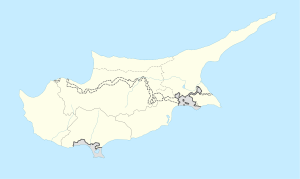Ktima
|
Paphos Πάφος (Greek) Baf (Turkish) |
||
|---|---|---|
 |
||
|
||
| Coordinates: 34°46′N 32°25′E / 34.767°N 32.417°E | ||
| Country |
|
|
| District | Paphos District | |
| Government | ||
| • Mayor | Phedonas Phedonos | |
| Elevation | 72 m (236 ft) | |
| Population (2015) | ||
| • City | 32,892 | |
| • Urban | 63,600 | |
| • Metro | 90,200 | |
| Demonym(s) | Pafitis | |
| Time zone | EET (UTC+2) | |
| • Summer (DST) | EST (UTC+3) | |
| Post code | 8000–8999 | |
| Website | pafos |
|
| UNESCO World Heritage Site | ||
| Criteria | Cultural: iii, vi | |
| Reference | 79 | |
| Inscription | 1980 (4th Session) | |
| Area | 162.0171 ha | |
Paphos /ˈpæfɒs/ (Greek: Πάφος [ˈpafos]; Turkish: Baf) is a coastal city in the southwest of Cyprus and the capital of Paphos District. In antiquity, two locations were called Paphos: Old Paphos, today at Kouklia, and New Paphos.
The current city of Paphos lies on the Mediterranean coast, about 50 km (30 mi) west of Limassol (the biggest port on the island), which has an A6 highway connection. Paphos International Airport is the country's second-largest airport. The city has a subtropical-Mediterranean climate, with the mildest temperatures on the island.
Paphos is included in the official UNESCO list of cultural and natural treasures of the world's heritage for its spectacular ancient remains, and was selected as a European Capital of Culture for 2017, along with Aarhus.
In the founding myth, even the town's name is linked to the goddess, as the eponymous Paphos was the son (or, in Ovid, daughter) of Pygmalion whose ivory cult image of Aphrodite was brought to life by the goddess as "milk-white" Galatea.
...
Wikipedia


